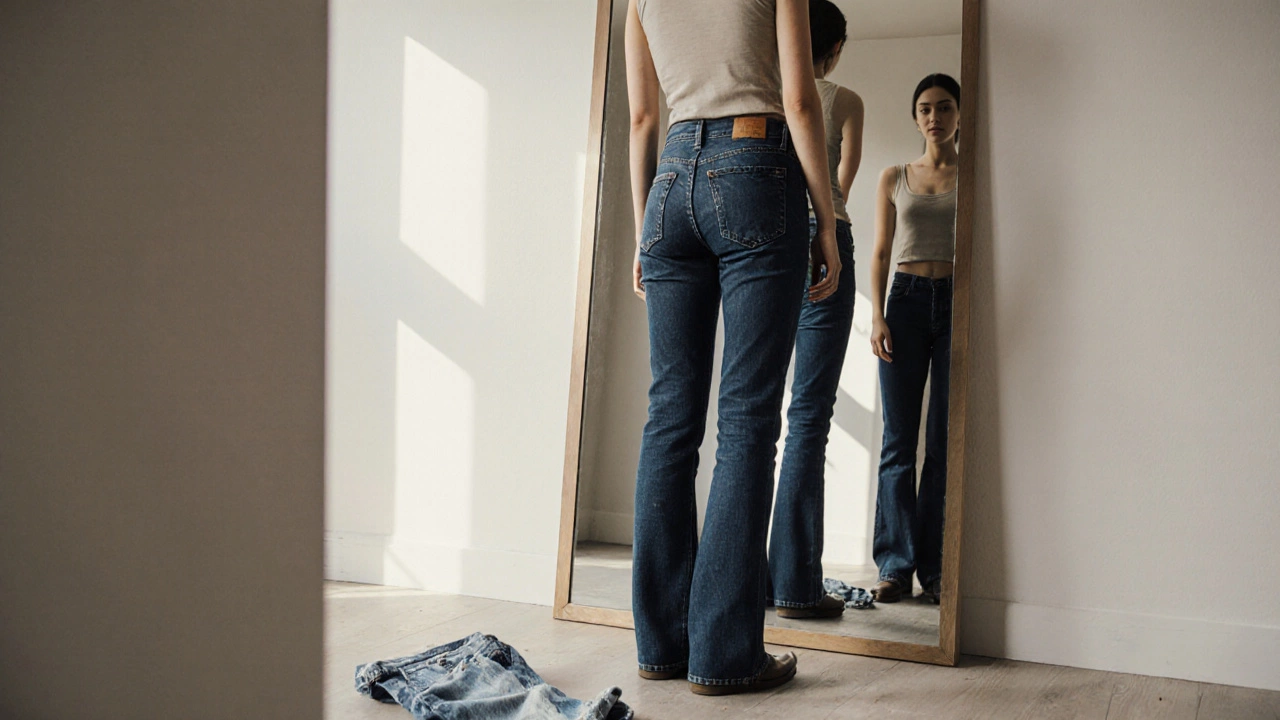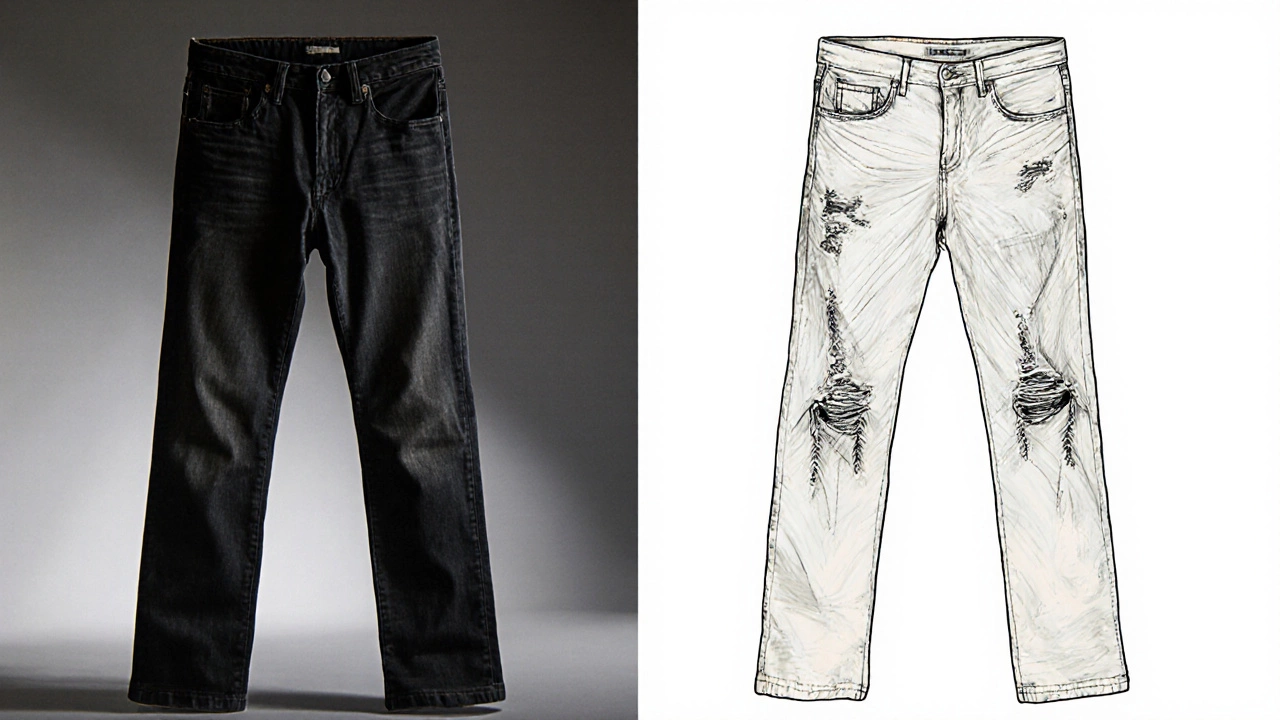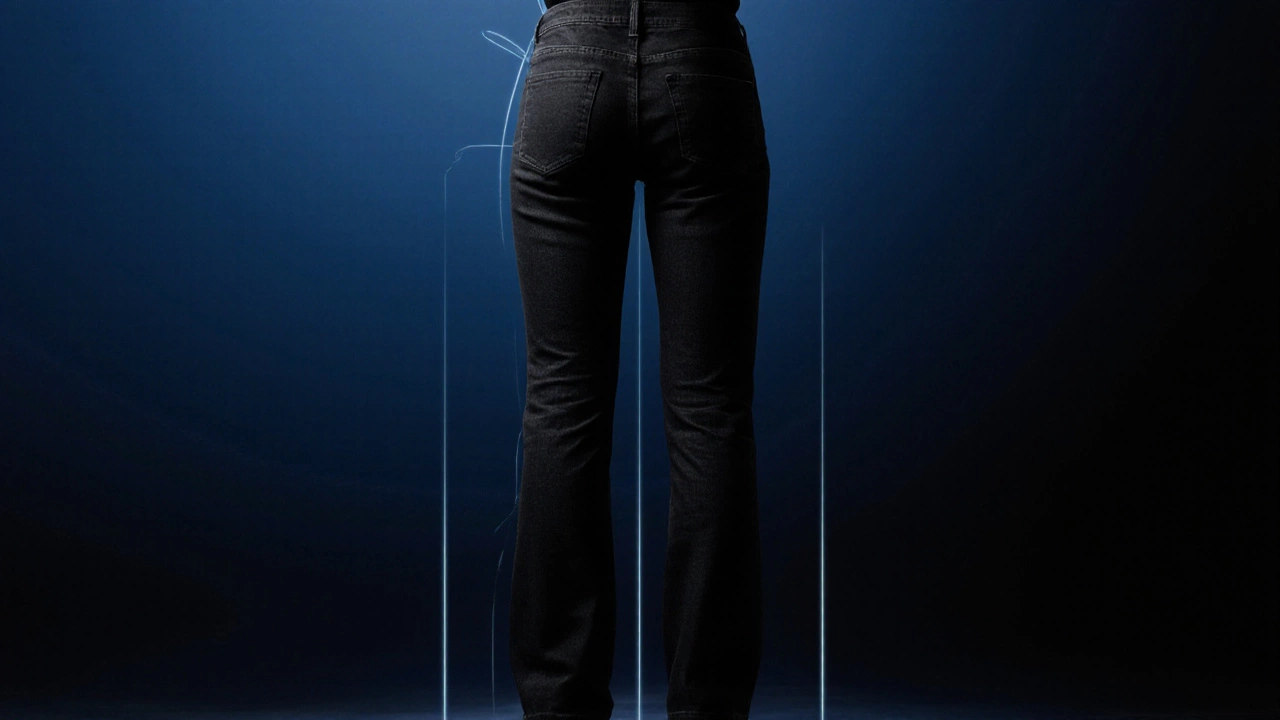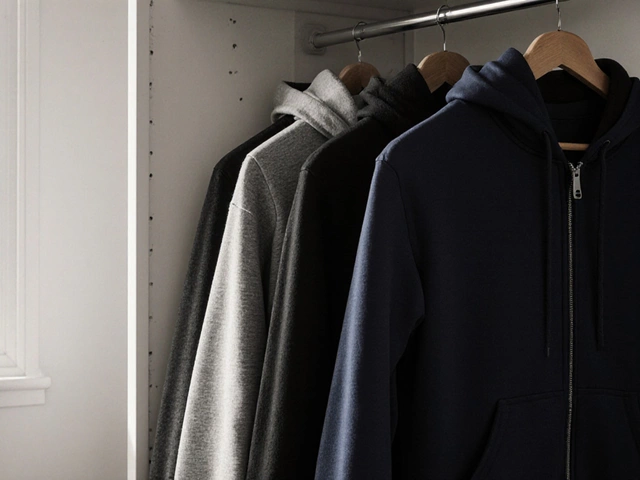What Color Jeans Make You Look Bigger? The Truth About Fit and Shade

- Cleo Fairchild
- 8 November 2025
- 0 Comments
Ever put on a pair of jeans and feel like they’ve added five pounds? You’re not imagining it. The color of your jeans can do more than just match your shirt-it can change how your body looks in the mirror. And no, it’s not just about fit. The shade you choose plays a real, measurable role in how others (and you) perceive your shape.
Dark jeans slim. Light jeans expand.
It’s not a myth. Dark denim-black, navy, charcoal-creates a slimming effect. Why? Because darker colors absorb light instead of reflecting it. This reduces visual contrast along your curves, making edges blur slightly. The result? A smoother silhouette. Studies in color psychology and garment design show that people consistently rate individuals wearing dark denim as looking slimmer, even when the cut and size are identical to lighter pairs.
On the flip side, light blue, white, or faded jeans reflect more light. That reflection draws attention to every contour, crease, and curve. It’s why a pair of ripped white jeans can make hips and thighs look wider, even if they’re the same size as your dark jeans. It’s not the fabric-it’s the optical illusion.
Washed-out and distressed? Watch out.
Distressed jeans aren’t just trendy-they’re visually busy. Fades, whiskering, and rips create multiple points of light reflection. Each highlight acts like a spotlight on a specific area. If your jeans have heavy fading across the thighs or knees, your body naturally follows those bright spots. That’s why you might feel like your legs look bigger in light-wash jeans with whiskering, even if the cut is flattering.
Try this: Compare two pairs of straight-leg jeans-one dark, one light with heavy fading. Stand in front of a full-length mirror in natural light. Notice how your eyes are pulled to the brightest areas. Now switch to the dark pair. The difference isn’t magic. It’s physics.
Black jeans aren’t always the answer
People assume black jeans = instant slimming. But if they’re too tight, too stretchy, or have a low-rise waist, they can actually make you look bulkier. Why? Because tight black fabric clings and highlights every bump. When denim hugs your body too closely, it creates sharp shadows and unnatural lines. That’s the opposite of slimming.
Look for dark jeans with a bit of structure-medium-weight cotton with just enough stretch to move, not cling. A mid-rise waist that sits at your natural waistline helps define your shape without squeezing. Brands like Levi’s 511, AGOLDE’s 90s Straight, and Everlane’s The Day Denim all use dark washes with smart tailoring that avoids the “sausage casing” effect.
What about colored jeans? Green, red, or brown?
Colored jeans fall into two categories: deep tones and bright tones. Deep colors like forest green, burgundy, or chocolate brown behave like dark denim. They absorb light and create a slimming effect. These are great alternatives if you’re tired of black but still want to minimize volume.
Bright colors-neon yellow, bright red, or pastel blue-act like light jeans. They reflect light and draw attention. If you’re wearing colored jeans, go for saturated, rich hues, not pastels. A deep teal or plum will flatter more than a baby blue. And avoid patterns or prints on colored denim. They add visual noise, which adds perceived bulk.

Fit matters more than color-but color decides the impact
Let’s be clear: a well-fitting pair of jeans will always look better than a poorly fitting one, no matter the color. But if you’re choosing between two jeans that fit equally well, the color will tip the scale.
Here’s a simple rule: if you want to look leaner, pick dark over light. If you want to look more voluminous (say, for a fashion statement or to balance a narrow upper body), go for light or contrast washes.
Think of it like makeup. Contouring uses shadow to create the illusion of slimmer features. Dark jeans are the denim version of contouring. Light jeans are like highlighting-everything gets pulled forward.
Real-world test: Try this tomorrow
Don’t just take my word for it. Do this tonight:
- Put on your darkest pair of jeans. Stand in front of a mirror. Take a photo.
- Now put on your lightest pair. Take another photo.
- Compare them side by side. Don’t look at the fit. Look at the shape.
You’ll likely notice your waist looks narrower, your hips less prominent, and your legs appear longer in the dark pair-even if the jeans are the exact same size. That’s the power of color.
What about jeans with stretch?
Stretch denim is everywhere now. And yes, it can be flattering. But stretchy fabric in light colors? That’s a double whammy. The stretch hugs your body, and the light color reflects every little bulge. Dark stretch denim, though? That’s your best friend. The color hides the cling, and the stretch gives comfort without the visual bulk.
Look for jeans with 2-4% elastane. More than that, and the fabric loses structure. Less than 2%, and you lose comfort. The sweet spot is dark wash, 3% stretch, mid-rise, and a straight or slightly tapered leg.

What if you want to look bigger on purpose?
Some people wear light jeans to add volume. Maybe you’re thin and want to look more substantial. Maybe you’re curvy and want to emphasize your shape. That’s fine. Light jeans can be powerful tools for body expression. Just know the effect: you’re choosing visibility over minimization.
Pair light jeans with a fitted top or tucked-in shirt to create balance. Avoid oversized tops-they’ll make the contrast even more extreme. And if you’re going for a bold look, try colored jeans in deep tones instead of white. They give you volume without looking washed out.
Seasonal tips: Winter vs summer
In winter, dark jeans make sense. They blend with coats, boots, and layers. They don’t show dirt. And they help you look leaner under bulky sweaters.
In summer, light jeans are tempting. But if you’re concerned about how they look, stick to medium washes-not white. Medium blue has enough depth to avoid the reflective trap, but still feels fresh. Avoid bleached or acid-washed styles. They’re the worst for creating visual bulk.
And if you’re wearing sandals or barefoot in summer? Dark jeans still win. They create a continuous line from waist to ankle. Light jeans break that line at the foot, making legs look shorter and wider.
Final rule: Dark is default. Light is choice.
If you’re unsure, go dark. It’s the safest, most universally flattering option. It works for all body types, all ages, and all occasions. Light jeans aren’t bad-they just need intention. Wear them when you want to stand out, not when you want to blend in.
There’s no one-size-fits-all rule in fashion. But when it comes to color and perception, science doesn’t lie. Dark jeans don’t shrink you. They just make your body look more defined, more balanced, and more intentional.
Do black jeans make you look thinner than blue jeans?
Yes, black jeans typically make you look thinner than blue jeans because they absorb light and reduce visual contrast along your body’s curves. Light blue jeans reflect light, which highlights contours and can make hips and thighs appear wider-even if the fit is identical. The difference is optical, not physical.
Are light-wash jeans bad for big thighs?
Light-wash jeans aren’t inherently bad, but they can make thighs look larger because the faded areas reflect light and draw attention to those spots. If you have larger thighs and want to minimize their appearance, opt for dark washes with minimal fading. If you love light washes, choose ones with subtle distressing and pair them with a longer top to balance the look.
Can colored jeans slim you down?
Yes, but only if they’re deep, saturated colors like burgundy, forest green, or navy. These act like dark denim by absorbing light. Avoid pastels, bright reds, or neon shades-they reflect light and add visual volume. A rich plum or charcoal gray jean can be just as slimming as black.
Does stretch denim make you look bigger?
Stretch denim only makes you look bigger if it’s too tight and in a light color. The fabric clings and shows every curve. Dark stretch denim with 2-4% elastane, however, offers comfort without the visual bulk. The key is color and fit-dark and structured beats light and overly stretchy every time.
Should I avoid ripped jeans if I want to look slimmer?
Yes, if you’re aiming for a slimming effect. Rips and tears create bright, reflective spots that draw the eye to specific areas. Even small holes can make hips or thighs look wider. If you like the style, choose dark jeans with minimal distressing-just a few subtle frays near the hem. Avoid large rips on the thighs or knees.


